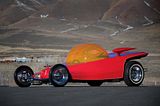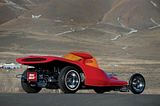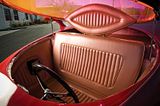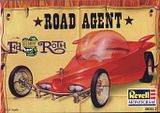Is a unique and downright futuristic custom creation from the fertile mind of one of the nation’s most creative and colorful artists and customizers - Ed “Big Daddy” Roth. Utilizing an innovative powertrain with a Corvair engine and rear suspension and employing Roth’s distinctive bubble top, Road Agent was the sixth in his line of cars. Restored by Mark Moriarty, it remains one of the most instantly recognizable icons of hot rod history.
Ca. 100 hp, 145 cu. in. overhead valve opposed six-cylinder engine, two-speed Powerglide automatic transmission, live axle front suspension with torsion bar, independent rear suspension with coil springs, two-wheel drum brakes.
While most Roth rods started out as bent conceptions of bodywork and chassis, Road Agent, created in 1964, was different. It was conceived as a radical drivetrain first. The severe wedge-shaped body followed as a consequence of Roth’s prescient decision to abandon big front-mounted V8 engine(s) and look to more innovative rear- and mid-engined layouts which gave his free-form concepts even more freedom to innovate dramatic bodywork.
The front-engined, rear wheel drive layout came close to maxing out with Mysterion’s pair of canted dual FE Fords. The dry lakes crowd could keep on adding engines. The drag bunch could pile massive superchargers on top of cubic inches. They were real cars but caricatures of Roth’s fanciful tee shirt monsters’ rides. Always a step (or two, or three) ahead of the wave, Roth rethought the entire subject.
Rod & Custom kept pushing the envelope, too, and Joe Henning sketched some outside-the-box concept designs. Roth disdained their front-mounted V8s and identified their flaws: obscured vision and a heavy and bulky drivetrain that encroached on the passengers’ area and interrupted the body’s visual flow. Ed had been reading Hot Rod’s annual recap of the design features as Indy Cars quickly moved from front- to mid-rear engined layouts.
He probably remembered, too, that Mysterion, for all its water-cooled twin Ford V8 muscle, had no realistic provision for radiators.
Roth seized upon Chevy’s then-new Corvair with its air cooled opposed flat six. Rear-mounted behind the rear axle it didn’t offer much to tight, integrated designs like Cooper, Lotus and that other Southern Californian iconoclast Mickey Thompson brought to the Speedway in 1963. Mid-engined, though, it was a fink of a different configuration.
Roth built a simple trussed four-rail frame of 1 ¾-inch 4130 tubing, then installed a 2-carb hopped up Corvair in the middle with a standard Powerglide automatic turned around to take the power from the front. He used the standard Corvair swing axle independent rear suspension (the one Ralph Nader later trashed – zinging Nader appealed to Roth) with coil springs and got the whole thing running.
Not surprisingly, the reversed Powerglide worked fine, but provided two speeds going backwards and only one, the Corvair’s reverse, going in the usual direction. Fixing that took a big dose of Southern Californian hot rod ingenuity, turning the differential upside down and a lot of creative plumbing to make it work. Roth’s layout employed a ’37 Ford tube axle up front.
He reprised the cup-mounted coil springs he’d used with effect on Mysterion but they were largely for show. The real springing was a cross-mounted VW torsion bar secured at its outside ends that supporting the axle with a single center arm. An Austin provided the steering gear and thee front wheels with Astro centers mount motorcycle tires, which are original to the car, as are the rear tires. In fact, the rear wheels are stamped with Roth on the inside.
Running and driving, the concept was nearly complete. A set of four exhaust pipes, admittedly superfluous on a flat six but looking great, completed the mechanicals. Roth and Joe Henning then came up with something appropriately bizarre to clothe it. With nothing in front of the driver except the wheels and suspension and an engine with a top-mounted cooling fan and carbs behind it driving a set of 6.70-15 narrow whitewall rear wheels the most sparse, simple layout was a narrow-nosed wedge shape. That is just what Roth and Henning developed.
It included a Roth bubble top over the passenger compartment. He and Acry Plastics had some experience by then and they molded the Road Agent’s bubble in a petal-shaped plan view. The orange-tinted plastic and contours suggested nothing less than a B-movie alien’s brain. There’s a wonderful photo of Road Agent at a car show with the dome reflecting the hall’s coffered ceiling that highlight its resemblance to the brain surface’s ridges, grooves and fissures.
Quad headlights were placed low in the nose behind translucent covers in eye-shaped ovoid openings that heightened Road Agent’s alien anthropomorphistic rendering. A small blanked-off recess in the nose between the lights credited the history of radiators that was missing from the air-cooled Road Agent. Roth created a whimsical winged Boyce Motometer hood ornament that had no thermometer in it, just an “Ed Roth” identification.
The body, molded with Roth’s “spitwad” technique, tapered back around the passenger compartment and flesh-colored dome and over the engine and rear suspension in a fair approximation of a paper airplane dart. Teardrop appendages erupted on each side of the dome. At one point they’d been conceived as complex antennas but in the end were simplified to harmonize with the simplicity of Road Agent’s fiberglass body. A single flattened oval at the back of the rear deck contained the rear lights. Below it the Corvair drivetrain and suspension is hung out there in the open for all to see and appreciate. An ovoid nerf bar, thin and fragile to the point of being little more than a broad curb feeler, marked Road Agent’s rear extremities. It was painted by Larry Watson with the pin-striping done in white by Roth.
The interior’s bench seat is rolled and pleated in Rose Pearl vinyl with matching deep pile carpet. A Dixco tach and pair of Stewart-Warner twin blue gauges are all the instruments the driver needs, and all that Roth provided. Only a lip-shaped ovoid headrest set high up above the body within the translucent dome extending across the seat’s full width and the tiny Delmonico television in the passenger’s door panel elevate form over function in the otherwise purposeful interior. The shifter handle is made from a ratchet wrench.
First featured in Rod & Custom in March 1964, Road Agent was accorded a two-page feature in the next month’s issue, then got Hot Rod’s attention in October. Roth then sold it to the Brucker Family’s MovieWorld museum before it joined the Harrah’s Collection and eventually found its way into an East Coast museum. Renowned Roth guru Mark Moriarty acquired the car in 2006 and sold it to the current owner in 2005. Moriarty restored Road Agent in 1997, meticulously retaining its originality in the process. It was displayed at the Los Angeles Museum of Art’s 2000-2001 “Made in California” exhibit, with the Roth rods at the 2006 Detroit Autorama and at the Petersen Museum in Los Angeles in 2007.
Road Agent marks an important departure in Roth’s rods. It was conceived and designed from the inside out, first as an innovative chassis and drivetrain incorporating air cooling and mid-engined dynamics. The body is functionally minimal. If it weren’t for the teardrop appendages, the eye-shaped headlights and the bright orange dome it could be the prototype for a mid-engined, Corvair-powered dune buggy, a genre that wouldn’t appear in Southern California for years.
Which, in a nutshell, typifies Ed Roth. He happily discarded preconceived notions, seeking new ways of achieving high performance and dramatic appearance. None of his creations better express that quest and its success than Road Agent, an accomplishment which has been amply recognized with a succession of exhibits, features and publications which give in the impeccable provenance of the work of kinetic art which it is.
Sold at auction by RM Auctions on Saturday, September 26, 2009 for $187,000 |









|




